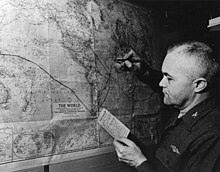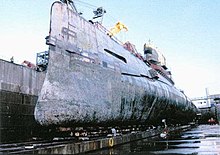USS Triton (SSRN-586)
[9] Triton's unique contribution to the development of nuclear power for naval propulsion was her dual reactor plant, which provided the speed required for radar picket missions.
[10] Radar picket submarines (Navy classification "SSR") were developed during the post-war period to provide intelligence information, electronic surveillance, and fighter aircraft interception control for forward-deployed naval forces.
[17] Subsequent growth of the SAR propulsion plant necessitated the overall increase in Triton's length and tonnage, although without any loss in speed, while the installation of the AN/SPS-26 3-D search radar allowed the elimination of a separate height-finder.
[27] Triton's dual-reactor plant met a number of operational and engineering objectives, specifically the high speed requirement to meet her radar picket mission, which continues to be a source of speculation and controversy to this day.
During the early 1950s, many engineers at Naval Reactors branch of the U.S. Atomic Energy Commission (AEC) were concerned about depending on single-reactor plants for submarine operations, particularly involving under-the-ice Arctic missions.
[32][35][36] The chin-mounted AN/BQR-2 passive sonar array supplemented the active BQS-4, with a range up to 10 nautical miles (19 km; 12 mi) and a bearing accuracy of 1/10 of degree, allowing the BQR-2 to be used for fire control in torpedo attacks.
[39][40] The U.S. Navy ordered a "large radar picket using the advanced two-reactor system", designated SCB 132, in October 1955 under the United States Department of Defense appropriation for Fiscal Year 1956.
At the recommendation of Admiral Rickover, a hose was rigged to spray the bearing housing with a steady stream of sea water to keep the shaft cool, as well as a special watch set to monitor the temperature of the lube oil.
Vice Admiral Bernard L. Austin, the Deputy CNO for Plans and Policy, made the keynote address, noting: As the largest submarine ever built, her performance will be carefully followed by naval designers and planners the world over.
[51][66][67] Work on Triton at Electric Boat was delayed as priority was given to completing the Navy's first two fleet ballistic missile (FBM) submarines, George Washington and Patrick Henry, with the objective for both vessels to start their first nuclear deterrence patrols before the end of 1960.
The mission's objectives were set forth in the published ship's log (pictured): For purposes of geophysical and oceanographic research and to determine habitability, endurance and psychological stress – all extremely important to the Polaris program – it had been decided that a rapid round-the-world trip, touching the areas of interest, should be conducted.
[72]The actual mission was summarized by the U.S. Navy's Dictionary of American Naval Fighting Ships: Triton put to sea on her shakedown cruise on 15 February 1960, bound for the South Atlantic.
After transiting the Philippine and Indonesian archipelagos and crossing the Indian Ocean, she rounded the Cape of Good Hope and arrived off the St. Peter and Paul Rocks on 25 April – 60 days and 21 hours after departing the mid-ocean landmark.
[73]Triton's commanding officer during Operation Sandblast, Captain Edward L. Beach, also provided a unique perspective on the circumnavigation in the published log: The sea may yet hold the key to the salvation of man and his civilization.
[74]The noted historian Bern Dibner placed the significance of Operation Sandblast into historical context: The epochal achievement of the fleet of Magellan in circumnavigating the globe was echoed in the magnificent accomplishment by the nuclear submarine Triton in 1960.
[76]The actual submerged circumnavigation occurred between 24 February and 25 April 1960, covering 26,723 nautical miles (49,491 km; 30,752 mi) in 60 days and 21 hours at the average speed of 18 knots (33 km/h; 21 mph) while crossing the Equator on four different occasions.
[77] The New York Times described Triton's submerged circumnavigation of the world as "a triumph of human prowess and engineering skill, a feat which the United States Navy can rank as one of its bright victories in man's ultimate conquest of the seas".
[73] Triton also participated in NATO exercises against British naval forces led by the aircraft carriers Ark Royal and Hermes under the command of Rear Admiral Sir Charles Madden, RN.
[79] For 2 days during these NATO exercises, Rear Admiral Thomas H. Moorer and his flag lieutenant, Lt. William P. Lawrence, were aboard Triton to observe the submarine's radar-picket operations.
[87][88] Because she subsequently served as COMSUBLANT's flagship following her overhaul, one area of continuing speculation is whether Triton was part of the National Emergency Command Post Afloat (NECPA) program.
NECPA was tasked to provide afloat facilities for the President of the United States in case of an emergency or war, with the command cruisers Northampton and Wright assigned to perform this mission.
[73] In August 1993, the hulks of the ex-Triton and the ex-Ray were towed by the salvage tug Bolster to the Puget Sound Naval Shipyard (PSNS), in Bremerton, Washington, arriving on 3 September 1993, to await their turn in the Nuclear Powered Ship and Submarine Recycling Program (SRP).
[73][101][102][103] To commemorate the first submerged circumnavigation of the world, all Triton personnel who made that voyage were authorized to wear their Presidential Unit Citation ribbon with a special clasp in the form of a golden replica of the globe (pictured).
[105] The plaque's eventual design consisted of a brass disk about 23 inches (58 cm) in diameter, bearing a sailing ship reminiscent of Magellan's carrack, Trinidad, above the submarine dolphin insignia with the years 1519 and 1960 between them, all within a laurel wreath.
A shadow box filled with Triton memorabilia was placed in Alcorn Auditorium of Ramage Hall located at the U.S. Navy Submarine Learning Center, Naval Station Norfolk.
Its purpose is "to establish a permanent park in north Richland in recognition of all the decommissioned reactor cores off-loaded at the Port's barge slip, transported and stored at the Hanford Site".
[129] Hosted by John D. Craig, this episode was titled Saga of the Triton, and it featured film footage from Operation Sandblast with voice-over narration extracted from Captain Beach's logbook.
In The Last Mayday by Keith Wheeler (1968), Triton is depicted as participating in a submarine training exercise at the beginning of the novel, with special notice made of her large, rectangular sail.
[143] The 50th anniversary of Operation Sandblast and Triton's submerged circumnavigation of the world was celebrated on 10 April 2010, during the 2010 Submarine Birthday Ball held at the Foxwoods Resort Casino in Mashantuket, Connecticut, with Master Chief Petty Officer of the Navy (MCPON) Rick D. West delivering opening remarks (pictured) to the 2,200 attendees.
[157] Finally, the Naval Institute Press published Beneath the Waves by Dr. Edward F. Finch, a 2010 biography of the late Captain Beach, which includes extensive coverage of Operation Sandblast.



















